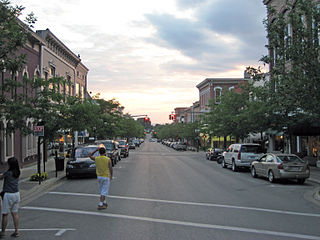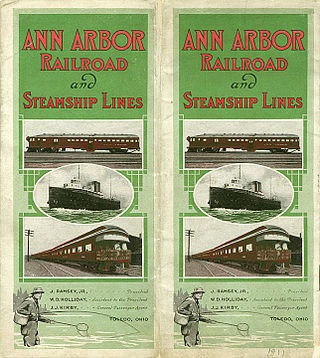
Petoskey is a city in the U.S. state of Michigan. It is the county seat of Emmet County, and is the largest settlement within the county. Petoskey has a population of 5,877 at the 2020 census, up from 5,670 at the 2010 census.
The Pere Marquette Railway was a railroad that operated in the Great Lakes region of the United States and southern parts of Ontario in Canada. It had trackage in the states of Michigan, Ohio, Indiana, and the Canadian province of Ontario. Its primary connections included Buffalo; Toledo; and Chicago. The company was named after Jacques Marquette, a French Jesuit missionary who founded Michigan's first European settlement, Sault Ste Marie.
The Thumb is a region and a peninsula of the U.S. state of Michigan, so named because the Lower Peninsula is shaped like a mitten. The Thumb area is generally considered to be in the Central Michigan region, east of the Tri-Cities and north of Metro Detroit. The region is also branded as the Blue Water Area.
The Detroit, Toledo and Ironton Railroad operated from 1905 to 1983 between its namesake cities of Detroit, Michigan, and Ironton, Ohio, via Toledo. At the end of 1970, it operated 478 miles of road on 762 miles of track; that year it carried 1,244 million ton-miles of revenue freight.

The Ann Arbor Railroad was an American railroad that operated between Toledo, Ohio, and Elberta and Frankfort, Michigan with train ferry operations across Lake Michigan. In 1967 it reported 572 million net ton-miles of revenue freight, including 107 million in "lake transfer service"; that total does not include the 39-mile subsidiary Manistique and Lake Superior Railroad.

Northern Michigan, also known as Northern Lower Michigan, is a region of the U.S. state of Michigan. A popular tourist destination, it is home to several small- to medium-sized cities, extensive state and national forests, lakes and rivers, and a large portion of Great Lakes shoreline. The region has a significant seasonal population much like other regions that depend on tourism as their main industry. Northern Lower Michigan is distinct from the more northerly Upper Peninsula and Isle Royale, which are also located in "northern" Michigan. In the northernmost 21 counties in the Lower Peninsula of Michigan, the total population of the region is 506,658 people.

The Michigan Central Railroad was originally chartered in 1832 to establish rail service between Detroit, Michigan, and St. Joseph, Michigan. The railroad later operated in the states of Michigan, Indiana, and Illinois in the United States and the province of Ontario in Canada. After about 1867 the railroad was controlled by the New York Central Railroad, which later became part of Penn Central and then Conrail. After the 1998 Conrail breakup, Norfolk Southern Railway now owns much of the former Michigan Central trackage.

The 2006 United States Senate election in Michigan was held November 7, 2006. Incumbent Democratic U.S. Senator Debbie Stabenow won re-election to a second term.

Durand Union Station is a historic train station in Durand, Michigan. The station, which now serves Amtrak Blue Water trains, was originally a busy Grand Trunk Western Railroad and Ann Arbor Railroad hub, as well as a local office for Grand Trunk Western, from its construction in 1903 until 1974. It is currently owned by the city of Durand and leased by Durand Union Station, Inc. a nonprofit organization dedicated to the preservation, restoration, and maintenance of the building and its surrounding property.

Railroads have been vital in the history of the population and trade of rough and finished goods in the state of Michigan. While some coastal settlements had previously existed, the population, commercial, and industrial growth of the state further bloomed with the establishment of the railroad.
The Michigan Northern Railway was a railroad that provided service to the northern part of the Lower Peninsula of Michigan from 1976 to 1986. At the beginning of service on April 1, 1976, the MIGN operated the former Grand Rapids and Indiana Railroad from Comstock Park to Mackinaw City and the Walton Junction Branch to Traverse City. In 1982, the MIGN assumed operation of the former Chesapeake and Ohio Railway from Grawn to Williamsburg and from Charlevoix to Petoskey, and the former Ann Arbor Railroad from Alma to Frankfort.
WALLY was a commuter rail service proposed in 2008 which would have linked the Michigan cities of Ann Arbor and Howell. It never got past the planning stages.

The Ann Arbor Railroad is a Class III Railroad that operates fifty miles of track from Toledo, Ohio, to Osmer, Michigan. The railroad is operated by Watco and is based in Howell, Michigan. Prior to Watco's purchase of the railroad in 2013, the railroad was operated by the Ann Arbor Acquisition Corporation from 1988 to 2013, by the Michigan Interstate Railway from 1977 to 1988, and as a privately owned enterprise prior to 1977.
The following is a brief history of the North American rail system, mainly through major changes to Class I railroads, the largest class by operating revenue.

Lake State Railway is a railroad operating in the Saginaw Valley and northeastern quadrant of the Lower Peninsula of Michigan. The railroad moves large quantities of aggregate and limestone, as well as coal, grain, and chemical products. Some of the company's largest customers include Dow Chemical Company, S. C. Johnson & Son, Lafarge, ConAgra Foods, Archer Daniels Midland, Conrad Yelvington Distributors, and Consumers Energy.

Huron and Eastern Railway is a short line railroad operating 394 miles (634 km) of track in The Thumb and Flint/Tri-Cities area of the lower peninsula of Michigan. It is currently owned by Genesee & Wyoming, Inc., who purchased it from RailAmerica in 2012. Its headquarters is in the former Michigan Central Railroad depot in Vassar, Michigan.
The Michigan Interstate Railway was formed on August 27, 1977, to operate the Ann Arbor Railroad from Toledo, Ohio to Elberta, Michigan. The AA had declared bankruptcy and was included in the assets of Conrail, formed on April 1, 1976. The MIRC operated until October 7, 1988, when the Ann Arbor Acquisition Corporation acquired all assets.










